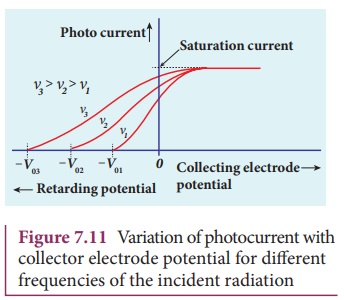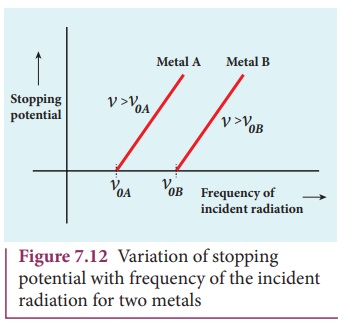Photo Electric Effect | Physics - Effect of frequency of incident light on stopping potential | 12th Physics : UNIT 8 : Dual Nature of Radiation and Matter
Chapter: 12th Physics : UNIT 8 : Dual Nature of Radiation and Matter
Effect of frequency of incident light on stopping potential
PHOTO ELECTRIC EFFECT
Effect of frequency of incident light on stopping potential
To study the effect of frequency of incident light on stopping potential, the intensity of the incident light is kept constant. The variation of photocurrent with the collector electrode potential is studied for radiations of different frequencies and a graph drawn between them is shown in Figure 7.11. From the graph, it is clear that stopping potential vary over different frequencies of incident light.

Figure 7.11 Variation of photocurrent with collector electrode potential for different frequencies of the incident radiation
Greater the frequency of the incident radiation, larger is the corresponding stopping potential. This implies that as the frequency is increased, the photoelectrons are emitted with greater kinetic energies so that the retarding potential needed to stop the photoelectrons is also greater.

Now a graph is drawn between frequency and the stopping potential for different metals (Figure 7.12). From this graph, it is found that stopping potential varies linearly with frequency. Below a certain frequency called threshold frequency, no electrons are emitted; hence stopping potential is zero for that reason. But as the frequency is increased above threshold value, the stopping potential varies linearly with the frequency of incident light.
Laws of photoelectric effect
The above detailed experimental investigations of photoelectric effect revealed the following results:
i) For a given frequency of incident light, the number of photoelectrons emitted is directly proportional to the intensity of the incident light. The saturation current is also directly proportional to the intensity of incident light.
ii) Maximum kinetic energy of the photo electrons is independent of intensity of the incident light.
iii) Maximum kinetic energy of the photo electrons from a given metal is directly proportional to the frequency of incident light.
iv) For a given surface, the emission of photoelectrons takes place only if the frequency of incident light is greater than a certain minimum frequency called the threshold frequency.
v) There is no time lag between incidence of light and ejection of photoelectrons.
Once photoelectric phenomenon has been thoroughly examined through various experiments, the attempts were made to explain it on the basis of wave theory of light.
Related Topics